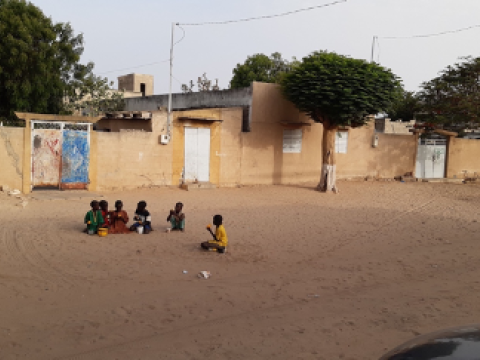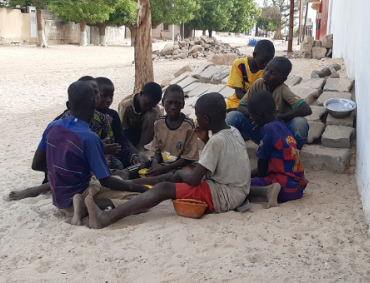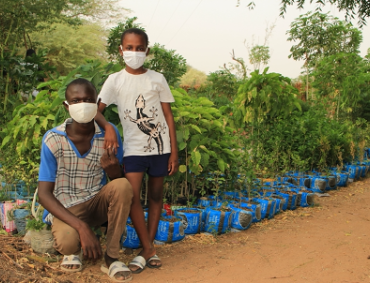The Prayers of the Talibés (2)
yalna laa baay laate, dugal la ci poosam yobu la aldiana !
yalna nga àjji màkka
yalna nga giseek seriñ tuuba yoomalxiyaam
yalna la borom bi bindal tuyaaba
yalna nga amm ay seex
yalna nga tabbi ci teenu xaalis ñu lay gene ngay bañ
May God make Baye Lahat put you in his pocket and enter with you into Heaven.
May God give you the grace to perform Hajj in Makkah
May God make you meet Serigne Touba in the afterlife
May God record this good deed for you...
May God have you give birth to twins...
The talibés have a practice that they all undertake: to formulate prayers for the donor. By taking a close look at what they say in these prayers, we realize that they are inspired by what they think, rightly or wrongly, are the donor's concerns. For example, I noticed that they formulate different prayers for women and men, young and old. Pushing a little further, I also realized that they have not always prayed in the same way over time. In the 90s, there was a talibé who used to come to our house and whom we liked very much because he had a joyful, singing and funny way of praying: « yalna laa baay laate, dugal la ci poosam yobu la aldiana ! ( May God make Baye Lahat[1] put you in his pocket and enter with you into Heaven. For him and for all the talibé of our youth, the prayers essentially referred to considerations of salvation: « yalna nga àjji màkka »[2] « yalna nga giseek seriñ tuuba yoomalxiyaam »[3] « yalna la borom bi bindal tuyaaba »[4] etc.
After the 2000s, we used to hear other types of prayers: « yalna nga amm saaku xaalis »[5] et « yalna nga tabbi ci teenu xaalis ñu lay gene ngay bañ »[6] for men, « yalna nga amm ay seex »[7] for women of a certain age. I realized that the prayers have evolved towards more concrete concerns, perhaps indicating what is most urgent for our societies in these difficult times.
In 2020, the covid19 seems to have logically found a place in the prayers of this young talibé.
[1] Baye Lahat is the other name of Abdoul Ahad Mbacké (1914-1989) son of the founder of the Murid brotherhood in Senegal and Khalif of this brotherhood from 1968 to his death.
[2] May God give you the grace to perform Hajj in Makkah (one of the five pillars of Islam).
[3] May God make you meet Serigne Touba (Sheikh Ahmadou Bamba also known as serigne touba is the founder of the Murid brotherhood in Senegal) in the afterlife (implied, so that he may lead you to salvation).
[4] May God record this good deed for you...
[5] May God give you a bag full of money...
[6] May God cause you to fall into a well full of money and when they try to get you out you refuse categorically to come out
[7] May God have you give birth to twins...
Sheikh Ahmadou Bamba also known as serigne touba is the founder of the Murid brotherhood in Senegal
Senegal




Comments
Very insightful on care - exchange during the pandemic
Dear Bruno, What an interesting idea to look at the songs and compare them with the prayers from the 90's. Thank you for sharing your insights about gender and class aspirations in contemporary Senegal through the voices of the talibes. I am curious about the wish for twins!
Thanks - more information on twins
Dear Aarti, Thank you very much for your interest in this text. You are right, the issue of twins needs to be clarified. In Senegalese society in the 1990s and even today, the social pressure to procreate was very strong on married women, and the absence of children caused them marginalization and stigmatization on all sides. The desire for a child was therefore very strong and the child had a great social and symbolic value for them. Since a single birth is the rule, we can already get an idea of what the exception - the birth of two children at the same time - could mean in such a context. However it should be pointed out that at that time a whole symbolism (originating essentially in the mythology of African cosmogonies) existed in the collective imagination about twins. This symbolism consisted of adoration/fascination mixed with fear, as twins were considered "powerful" beings endowed with supernatural powers and capable of using it both benevolently and maliciously. At the same time, Senegalese society, which was highly Islamized, was also influenced by Islam on this point. For example, the names given to twins were either "aadama ak awa" (Adam and Eve) or "àsan ak useïnu" (Hassan and Hussein), and the birth of twins was considered, in reference to Islamic beliefs, as a divine blessing. The young talibés who formulated this prayer had no doubt collected it in the collective imagination, influenced above all by Islam, and where wishing a woman to give birth to twins, an exceptional birth, seemed to be a way of wishing her an exceptional blessing.
The 'twins'
Bruno this is such a fascinating series of prayers and the changes over the years.... the wording of the blessing of wealth is very interesting as well as 'twins'. The ambivalence of twins is really noteworthy. it would be great if you could convert the above into another accession card or a several of them on the dynamics of 'twins'. I wonder what the talibés themselves think of this even though they learn it in the Koranic schools.
The twins
Thank you Cheryl. The point of twins is indeed very interesting, yesterday I talked a little bit about it with my parents, and they taught me a lot about how twins are understood in my culture; they gave me the example of one of my aunts in the village, who had separated her twins after weaning. She had kept one (adama) and the other (awa) was in the care of close relatives but living in a distant village. So the two twins grew up separated, to prevent the one with more "power" from hurting her sister. What is interesting is that before the birth of the twins, she first had twins (àsan and useïnu) and unfortunately useïnu died at an early age. If you think it might be interesting to go deeper into the issue of twins, I might be able to gather more information about it and write 2 or 3 accession cards.